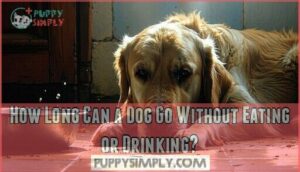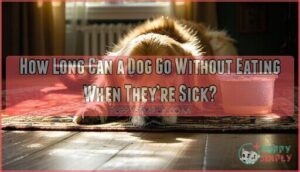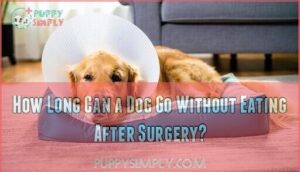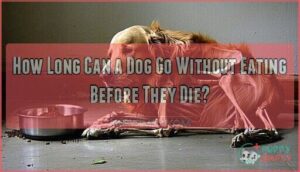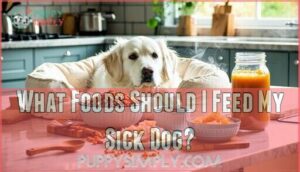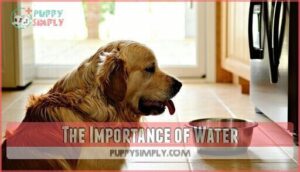This site is supported by our readers. We may earn a commission, at no cost to you, if you purchase through links.
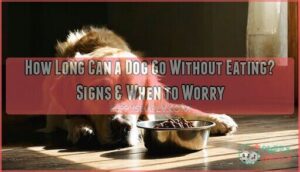 A healthy adult dog can typically survive 3-5 days without food, though this isn’t something you’d want to test.
A healthy adult dog can typically survive 3-5 days without food, though this isn’t something you’d want to test.
Puppies, senior dogs, and pups with health issues can’t go nearly as long – sometimes just 12-24 hours before serious problems develop.
Your dog’s size, age, and overall health play huge roles in how long they can fast safely.
While dogs can handle short periods without food better than we can, going without water is far more dangerous – dehydration can become life-threatening within days.
If your furry friend suddenly turns their nose up at dinner, don’t panic immediately, but keep a close eye on them, as understanding the warning signs and knowing when to act can make all the difference in your dog’s wellbeing.
Table Of Contents
- Key Takeaways
- How Long Can a Dog Go Without Eating?
- How Long Can a Dog Go Without Eating or Drinking?
- How Long Can a Dog Go Without Eating When They’re Sick?
- How Long Can a Dog Go Without Eating After Surgery?
- How Long Can a Dog Go Without Eating Before They Die?
- What Can Cause a Dog to Stop Eating?
- How Can You Encourage Your Dog to Eat?
- What Foods Should I Feed My Sick Dog?
- The Importance of Water
- Frequently Asked Questions (FAQs)
- How to help a sick dog that won’t eat?
- What are the signs of dehydration in a dog?
- What are the dangers of not eating for 5+ days?
- Are there any home remedies to help stimulate a dog’s appetite?
- What foods should be avoided when feeding a dog?
- How can I tell if my dog is in pain or stressed?
- How does a dogs breed affect starvation survival?
- Can overweight dogs survive longer without food?
- What blood tests show starvation in dogs?
- Do outdoor dogs starve faster than indoor?
- Conclusion
Key Takeaways
- Your healthy adult dog can survive 3-5 days without food, but you shouldn’t wait that long – puppies, senior dogs, and sick pets need help within 24 hours due to their limited energy reserves and faster metabolism.
- Water’s more critical than food – your dog can only survive 3-5 days without water compared to weeks without food, so dehydration becomes life-threatening much faster than starvation.
- You’ll see warning signs before it’s too late – watch for sticky gums, sunken eyes, extreme lethargy, and behavioral changes that signal your dog needs immediate veterinary care.
- Don’t panic if your dog skips one meal, but act quickly if it continues – contact your vet if appetite loss persists beyond 24-48 hours, especially when combined with other symptoms like vomiting or lethargy.
How Long Can a Dog Go Without Eating?
Most healthy adult dogs can survive 3-5 days without food, though breed susceptibility varies substantially.
Your dog’s starvation bodyweight threshold becomes critical when they lose 35-50% of ideal weight—a dangerous zone requiring immediate veterinary intervention.
Hydration impact determines survival more than food; dogs won’t eat if severely dehydrated.
Organ damage begins after day three without nutrition.
Puppy owners should note that newborns need frequent feeding, as their survival without nutrition is limited to 24-48 hours.
If your dog won’t eat for 48+ hours, don’t wait to see how long your dog can starve—contact your vet immediately.
How Long Can a Dog Go Without Eating or Drinking?
When your dog won’t eat or drink, you’re facing a medical emergency.
Water deprivation is more dangerous than food starvation—dogs can survive only 3-5 days without water compared to 1-2 weeks without food. A dog’s survival also hinges on access to clean water.
Here are critical warning signs to watch for:
- Dehydration symptoms – Sunken eyes, dry gums, and loss of skin elasticity appear within 24 hours
- Combined refusal risks – Refusing both food and water for over 24 hours requires emergency vet care
- Breed differences – Small breeds and puppies deteriorate faster due to limited body reserves
- Age factors – Senior dogs and those with health conditions face shortened survival windows
Contact your veterinarian immediately if your dog shows these symptoms, as mortality risk spikes dramatically without proper hydration.
How Long Can a Dog Go Without Eating When They’re Sick?
When illness strikes, your furry friend’s appetite often disappears first.
A sick pup’s first sign of trouble? Their food bowl stays full.
Sick dogs typically survive 3-5 days without food, but this window shrinks dramatically for certain vulnerable groups.
Here’s what affects your sick dog’s fasting tolerance:
- Puppies and small breeds risk dangerous hypoglycemia within 24 hours due to high metabolic rates
- Senior dogs have limited energy reserves and may struggle after just one day without food
- Underlying illness impact varies – infections and gastrointestinal issues reduce tolerance substantially
Veterinary intervention urgency increases when dog health concerns persist beyond 48 hours.
Watch for dehydration signs like sticky gums or lethargy, as these compound the risks.
Dogs without water can experience organ damage quickly, making hydration a priority.
If you’re wondering about reasons your dog won’t eat, underlying conditions often suppress appetite through pain or nausea.
Don’t wait – veterinary advice for dogs experiencing prolonged appetite loss can prevent serious complications.
How Long Can a Dog Go Without Eating After Surgery?
Post-surgery recovery brings unique challenges for your furry friend’s appetite. Anesthesia effects and pain management medications can suppress hunger signals, making your dog reluctant to eat for 12-24 hours after surgery.
While this recovery timeline is normal, monitoring becomes essential since sick dogs shouldn’t go beyond 24 hours without nourishment. Puppies, however, are more vulnerable, and hypoglycemia can develop within 24 hours of food refusal.
Here’s how to support your recovering pup:
- Offer easily digestible foods like boiled chicken and rice to tempt their appetite
- Ensure proper pain management with veterinary-prescribed medications to restore comfort
- Watch for dehydration signs including lethargy and sticky gums requiring immediate attention
- Contact your vet promptly if dog appetite loss extends beyond 24 hours post-surgery
Breed variations affect recovery speed, with smaller dogs needing earlier intervention due to faster metabolism and limited energy reserves.
How Long Can a Dog Go Without Eating Before They Die?
Within days of extended dog starvation, survival becomes increasingly uncertain as organ failure threatens your pet’s life.
**Extended starvation pushes dogs toward life-threatening organ failure within days.
The starvation timeline varies substantially based on individual factors, with healthy dogs typically surviving 3-7 days without food before facing life-threatening complications.
Here are five critical warning signs your dog faces imminent danger:
- Severe weight loss exceeding 10% of body weight signals organ stress
- Puppy vulnerability increases dramatically – small breeds risk hypoglycemia within 12 hours
- Dehydration risks compound rapidly when dogs stop eating and drinking
- Organ failure begins after 5+ days of complete food refusal
- Behavioral changes like extreme lethargy indicate metabolic collapse
Newborn puppies require feeding every two hours to avoid critical health issues.
Contact your veterinarian immediately if your dog won’t eat for 48+ hours, or within 24 hours for sick, elderly, or small dogs.
What Can Cause a Dog to Stop Eating?
Several factors can make your dog turn their nose up at dinner.
Medical conditions like gastrointestinal disorders affect appetite in many dogs, while dental issues make eating painful for over 80% of dogs aged three and older.
Medication side-effects from antibiotics or pain relievers commonly suppress hunger.
Stress and anxiety from environmental changes disrupt eating patterns in up to 60% of cases.
Behavioral factors, toxin ingestion, and inadequate pain management also rank among top reasons dogs won’t eat regularly.
Sometimes, dogs may refuse food due to food allergy symptoms.
How Can You Encourage Your Dog to Eat?
When your dog’s appetite disappears, you’ll need smart strategies to reignite their interest in food. Creating the right feeding environment makes a huge difference – serve meals in quiet spaces away from distractions. Palatability enhancement works wonders: warm food slightly to release enticing aromas, or mix wet food with kibble for better texture.
Hand-feeding techniques provide comfort while encouraging eating, especially during recovery periods. If basic methods fail, your vet might recommend appetite stimulants or suggest home-cooked meals with lean proteins. One option to keep in mind is meat based baby food, but always avoid onion and garlic.
Here are four proven appetite stimulation methods:
- Add low-sodium broth to kibble for extra flavor and moisture
- Serve smaller, frequent meals instead of large portions
- Use puzzle feeders to make eating mentally engaging
- Maintain consistent schedules to establish healthy eating routines
Never force-feed your dog, as this creates negative associations with mealtime and increases stress.
What Foods Should I Feed My Sick Dog?
When your dog’s appetite disappears during illness, offering the right foods can make all the difference.
A bland diet works best for sick dogs – think boiled chicken and rice, which are gentle on upset stomachs.
Chicken broth adds flavor while providing hydration.
Soft foods like wet dog food are easier to digest than kibble.
Start with small portions to avoid overwhelming their system.
Palatable options include plain cooked chicken or low-sodium broth mixed with rice.
For picky eaters, consider warming the food to enhance its aroma, as this can help stimulate their appetite; you can also try low sodium bone broth.
Always follow vet recommendations for specific dietary needs during recovery, as some conditions require special nutrition plans.
The Importance of Water
While feeding your sick dog matters, water access is equally important for recovery.
Dehydration symptoms like sticky gums and lethargy can appear within 24 hours without drinking water.
Organ damage occurs after prolonged water deprivation, making consistent dog water intake critical.
You can enhance palatability by adding low-sodium broth to their water bowl. Consider also that unsalted bone broth can provide extra nutrients.
This broth benefits both hydration and appetite. Never force-feed, but encourage regular drinking water consumption to prevent serious dog dehydration complications.
Frequently Asked Questions (FAQs)
How to help a sick dog that won’t eat?
Like a flickering flame needs gentle coaxing, your sick pup requires patience and care.
Try warming bland foods like boiled chicken or rice, add low-sodium broth for flavor, and hand-feed small portions.
If they refuse food beyond 24 hours, contact your vet immediately.
What are the signs of dehydration in a dog?
You’ll spot dehydration when your dog’s gums feel dry and sticky, their eyes look sunken, and they seem unusually tired or lethargic, losing that usual spark.
What are the dangers of not eating for 5+ days?
Five days without food pushes your dog’s body beyond dangerous limits, triggering organ damage, severe weakness, blood chemistry changes, stomach ulcers, and potentially life-threatening complications that require immediate veterinary intervention.
Are there any home remedies to help stimulate a dog’s appetite?
You can warm food slightly to enhance its aroma, add low-sodium chicken broth, try different flavors, hand-feed small amounts, or offer bland boiled chicken and rice to jumpstart appetite.
What foods should be avoided when feeding a dog?
Countless foods can poison your pup, but chocolate, grapes, onions, garlic, and xylitol-containing products top the danger list.
You’ll also want to skip avocados, nuts, fatty foods, and anything with caffeine to keep your furry friend safe.
How can I tell if my dog is in pain or stressed?
Watch for behavioral changes like whimpering, panting, restlessness, aggression, or hiding.
Physical signs include trembling, excessive drooling, loss of appetite, and reluctance to move.
You’ll notice unusual postures or guarding specific body areas, which can be clear indicators of physical issues, and behavioral changes.
How does a dogs breed affect starvation survival?
While you might think all dogs starve at the same rate, breed differences in energy levels and metabolic rates actually affect how long they’ll survive without food.
With high-energy breeds depleting reserves faster, the variation in survival time without food becomes apparent, influenced by these breed-specific factors.
Can overweight dogs survive longer without food?
Yes, overweight dogs can survive longer without food than their normal-weight counterparts.
Extra body fat provides additional energy reserves, allowing them to withstand starvation for extended periods before reaching dangerous weight loss thresholds.
What blood tests show starvation in dogs?
Ironically, while you’re worried about your dog’s appetite, blood tests reveal the harsh truth about starvation: low albumin, platelets, red blood cells, and calcium levels, plus elevated BUN indicate nutritional crisis.
This sentence is already a complete concept and does not require further separation.
Do outdoor dogs starve faster than indoor?
Outdoor dogs face harsher conditions that accelerate starvation.
Cold weather, lack of shelter, and increased energy needs for temperature regulation mean they’ll weaken faster than indoor dogs in comfortable, controlled environments.
Conclusion
Understanding how long can a dog go without eating isn’t just academic knowledge—it’s potentially life-saving information every pet owner needs.
While healthy adult dogs can survive several days without food, you shouldn’t wait that long to seek help.
Puppies, senior dogs, and sick pets face much shorter timeframes before complications arise.
Pay attention to your dog’s eating habits, maintain fresh water access, and contact your veterinarian if appetite loss persists beyond 24-48 hours, especially with other concerning symptoms.
- https://a-z-animals.com/pets/dogs/dog-facts/how-long-your-dog-can-go-without-eating/
- https://pmc.ncbi.nlm.nih.gov/articles/PMC6961514/
- https://www.paolivet.com/health/dog-not-eating/
- https://secure.balanceit.com/index.php
- https://pangovet.com/?utm_source=dogster&utm_medium=article&utm_campaign=dog_eat_drink

